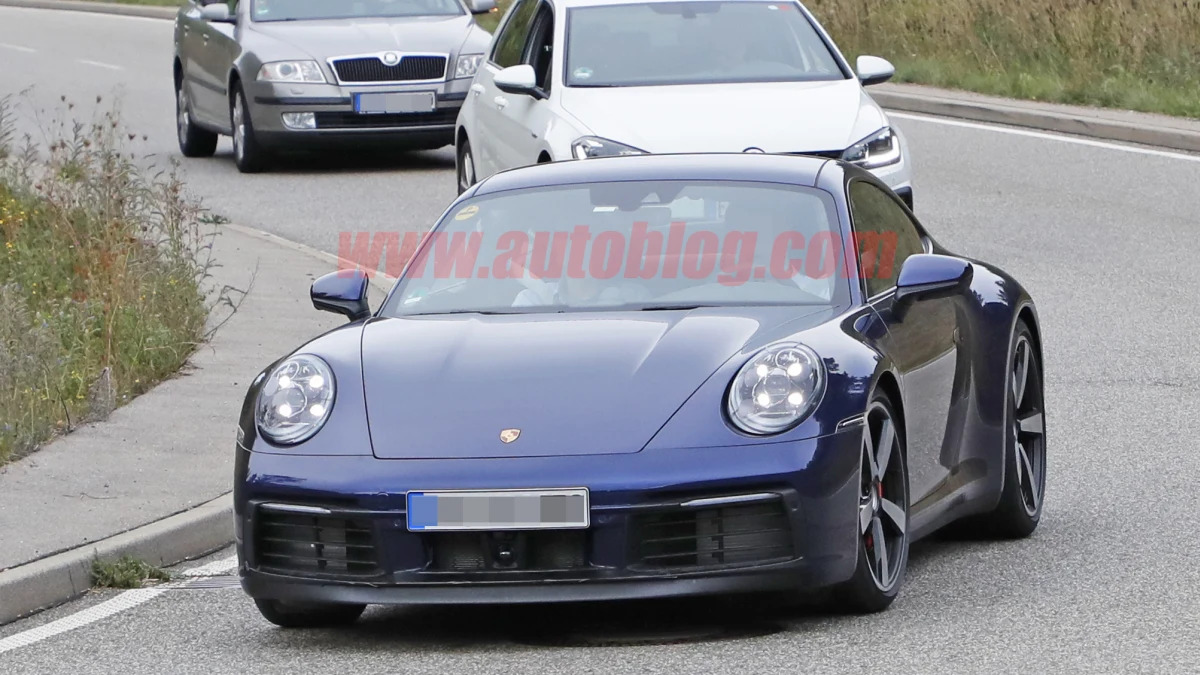Car and Driver rode shotgun with Porsche engineers during a prototype development drive of the coming 992-series 911. The mag picked up a host of insights, from power figures to info on the extra gear in the transmission and the new staggered wheel sizes. CD also found out that all of the standard Carrera models will go widebody, fitted with 72-inch-wide rear fenders. The current widebody models are 71.2 inches wide. As far back as the 993 series, Porsche differentiated base Carreras from Carrera S, all-wheel-drive, and GTS trims by putting wider fenders on the more expensive models.
Overall, the car grows by about an inch in length due to a longer front overhang, but stays on the same wheelbase. Weight holds about steady with the current 991.2 series, even though the 992 gets stamped aluminum fenders instead of steel units, saving from 22 to 33 pounds.
The front fenders stretch 1.6 inches wider to cover a front track that's grown by that amount, and all models will get staggered wheel sizes; that treat used to be reserved for the RS trims. The reasons for the extra body width and larger tires are, unsurprisingly, grip and handling. Regarding the tires, the widths remain the same at 8.5 inches in front and 11.5 inches in back. However, the base 992-series Carrera gets 19-inch wheels in front and 20-inch wheels in back, the S models get 20-inchers ahead and 21-inchers astern. Porsche said it wanted a larger contact patch because, "In a rear-heavy car like the 911, anything you do to increase rear grip helps the handling significantly."
Output on the entry-level Carrera climbs 15 horsepower to 385 hp, the S trim gets a boost of 30 hp to 450 hp, and the GTS should ring in at about 480 hp. A host of incremental changes to the turbocharged engines are responsible for that power, including cast iron headers instead of the current double-walled stamped steel, a larger intercooler, larger compressors and turbines with lower boost pressures, piezo injectors, and a higher compression ratio.
The seven-speed transmission might feature a new final-drive ratio to account for the larger wheels, but is otherwise unchanged. The seven-speed PDK becomes an eight-speed PDK, but it's not a fuel economy move yet. The new unit takes up less space in the same bell housing, which will ultimately make room for an electric motor in the oft-predicted hybrid 911.
Check out the Car and Driver article for a lot more information on the coupe we expect to see at next month's LA Auto Show. Other topics covered include aesthetic revisions such as the wider spoiler and ornamental, free-floating exhaust tips, new engine mounts, the two Wet driving modes, the highly digital instrument cluster, optional night vision system, reworked buttons and controls, and how the interior looks and feels cheaper.
Related Video:
Overall, the car grows by about an inch in length due to a longer front overhang, but stays on the same wheelbase. Weight holds about steady with the current 991.2 series, even though the 992 gets stamped aluminum fenders instead of steel units, saving from 22 to 33 pounds.
The front fenders stretch 1.6 inches wider to cover a front track that's grown by that amount, and all models will get staggered wheel sizes; that treat used to be reserved for the RS trims. The reasons for the extra body width and larger tires are, unsurprisingly, grip and handling. Regarding the tires, the widths remain the same at 8.5 inches in front and 11.5 inches in back. However, the base 992-series Carrera gets 19-inch wheels in front and 20-inch wheels in back, the S models get 20-inchers ahead and 21-inchers astern. Porsche said it wanted a larger contact patch because, "In a rear-heavy car like the 911, anything you do to increase rear grip helps the handling significantly."
Output on the entry-level Carrera climbs 15 horsepower to 385 hp, the S trim gets a boost of 30 hp to 450 hp, and the GTS should ring in at about 480 hp. A host of incremental changes to the turbocharged engines are responsible for that power, including cast iron headers instead of the current double-walled stamped steel, a larger intercooler, larger compressors and turbines with lower boost pressures, piezo injectors, and a higher compression ratio.
The seven-speed transmission might feature a new final-drive ratio to account for the larger wheels, but is otherwise unchanged. The seven-speed PDK becomes an eight-speed PDK, but it's not a fuel economy move yet. The new unit takes up less space in the same bell housing, which will ultimately make room for an electric motor in the oft-predicted hybrid 911.
Check out the Car and Driver article for a lot more information on the coupe we expect to see at next month's LA Auto Show. Other topics covered include aesthetic revisions such as the wider spoiler and ornamental, free-floating exhaust tips, new engine mounts, the two Wet driving modes, the highly digital instrument cluster, optional night vision system, reworked buttons and controls, and how the interior looks and feels cheaper.
Related Video:










Sign in to post
Please sign in to leave a comment.
Continue